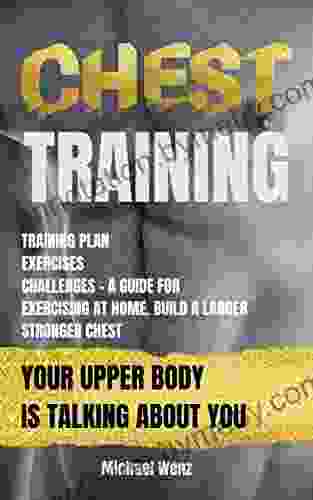Training Plan Exercises Challenges Guide For Exercising At Home Build Larger Muscles

Building muscle requires a dedicated training plan, effective exercises, and consistent effort. This comprehensive guide provides you with all the tools you need to build larger muscles from the comfort of your home. Whether you're a beginner or an experienced lifter, this guide will help you achieve your fitness goals.
4.6 out of 5
| Language | : | English |
| File size | : | 332 KB |
| Text-to-Speech | : | Enabled |
| Screen Reader | : | Supported |
| Enhanced typesetting | : | Enabled |
| Word Wise | : | Enabled |
| Print length | : | 138 pages |
| Lending | : | Enabled |
Training Plan
The training plan outlined in this guide is designed to help you build muscle mass and strength. The plan consists of three workouts per week, each focusing on a different muscle group. The workouts will gradually increase in intensity and volume over time, allowing you to progressively overload your muscles and stimulate growth.
- Workout 1: Chest, triceps, and shoulders
- Workout 2: Back, biceps, and forearms
- Workout 3: Legs and core
Workout Frequency
The recommended workout frequency is three times per week. This allows for sufficient recovery time between workouts and minimizes the risk of overtraining. If you're new to weightlifting, you may want to start with two workouts per week and gradually increase the frequency as you progress.
Workout Duration
Each workout should last approximately 60-90 minutes. This includes the warm-up, the exercises, and the cool-down. Don't be afraid to take rest breaks when needed. It's important to listen to your body and avoid overng it.
Progressive Overload
Progressive overload is a key principle of muscle building. It means gradually increasing the weight, sets, reps, or exercise difficulty over time. This challenges your muscles and forces them to adapt and grow. Without progressive overload, your muscles will plateau and you'll stop making progress.
Exercises
This guide includes a wide range of exercises that target all major muscle groups. The exercises are designed to be effective and safe for home workouts. You can use dumbbells, barbells, resistance bands, or bodyweight to perform the exercises.
- Chest: Barbell bench press, dumbbell flyes, push-ups
- Triceps: Triceps pushdowns, overhead triceps extensions, dips
- Shoulders: Overhead press, lateral raises, front raises
- Back: Barbell rows, pull-ups, lat pulldowns
- Biceps: Bicep curls, hammer curls, chin-ups
- Forearms: Wrist curls, reverse wrist curls, farmer's carries
- Legs: Barbell squats, leg press, lunges
- Core: Planks, crunches, leg raises
Exercise Selection
When selecting exercises, focus on compound movements that work multiple muscle groups at once. These exercises are more efficient and effective than isolation exercises that target a single muscle group.
Exercise Technique
Proper exercise technique is essential for maximizing results and minimizing the risk of injury. Make sure to learn the correct form for each exercise before you start lifting weights. You can find instructional videos online or consult with a qualified personal trainer.
Challenges
To keep your workouts challenging and progressive, incorporate the following challenges into your training plan:
- Increase the weight: As you get stronger, gradually increase the weight you're lifting.
- Increase the sets or reps: Once you can comfortably perform 12-15 reps of an exercise, increase the number of sets or reps.
- Shorten the rest periods: Between sets, take shorter rest periods to challenge your muscles and increase the intensity of your workouts.
- Try advanced variations: Once you've mastered the basic exercises, try more advanced variations that target specific muscle groups or challenge your stability and coordination.
Nutrition
Proper nutrition is essential for building muscle. Make sure to consume a balanced diet that includes plenty of protein, carbohydrates, and healthy fats. Protein is particularly important for muscle growth and repair. Aim to consume 1.6-2.2 grams of protein per kilogram of body weight per day.
- Protein sources: Meat, fish, poultry, eggs, dairy products, beans, lentils
- Carbohydrate sources: Brown rice, oatmeal, quinoa, fruits, vegetables
- Healthy fat sources: Avocados, nuts, seeds, olive oil
Supplements
Supplements can be helpful for supporting muscle growth and recovery, but they are not a substitute for proper training and nutrition. Some supplements that may be beneficial for building muscle include:
- Creatine: Creatine is a natural substance that increases muscle energy levels and helps you lift heavier weights.
- Whey protein: Whey protein is a high-quality protein that can help you meet your protein needs.
- BCAAs: BCAAs are essential amino acids that help reduce muscle soreness and promote recovery.
Rest and Recovery
Rest and recovery are just as important as training. Allow your muscles to rest and recover between workouts to prevent overtraining and promote muscle growth. Aim for 7-9 hours of sleep per night and take a day off from training once a week.
Building muscle at home requires dedication, consistency, and the right approach. This comprehensive guide provides you with all the tools you need to create a tailored training plan, select effective exercises, incorporate challenges, and optimize your nutrition and recovery. By following the principles outlined in this guide, you can achieve your goals and build larger muscles from the comfort of your own home.
4.6 out of 5
| Language | : | English |
| File size | : | 332 KB |
| Text-to-Speech | : | Enabled |
| Screen Reader | : | Supported |
| Enhanced typesetting | : | Enabled |
| Word Wise | : | Enabled |
| Print length | : | 138 pages |
| Lending | : | Enabled |
Do you want to contribute by writing guest posts on this blog?
Please contact us and send us a resume of previous articles that you have written.
 Book
Book Novel
Novel Page
Page Chapter
Chapter Text
Text Story
Story Genre
Genre Reader
Reader Library
Library Paperback
Paperback E-book
E-book Magazine
Magazine Newspaper
Newspaper Paragraph
Paragraph Sentence
Sentence Bookmark
Bookmark Shelf
Shelf Glossary
Glossary Bibliography
Bibliography Foreword
Foreword Preface
Preface Synopsis
Synopsis Annotation
Annotation Footnote
Footnote Manuscript
Manuscript Scroll
Scroll Codex
Codex Tome
Tome Bestseller
Bestseller Classics
Classics Library card
Library card Narrative
Narrative Biography
Biography Autobiography
Autobiography Memoir
Memoir Reference
Reference Encyclopedia
Encyclopedia Don Rosa
Don Rosa Diane Cardwell
Diane Cardwell J T R Brown
J T R Brown Diane Ackerman
Diane Ackerman Dennis Laumann
Dennis Laumann Jeff Booth
Jeff Booth Diana West
Diana West Denise Lewis Patrick
Denise Lewis Patrick Diana Rosado
Diana Rosado Denis Markell
Denis Markell Katie Cook
Katie Cook Russell Elkins
Russell Elkins Dita Von Teese
Dita Von Teese Diana Darke
Diana Darke Donald C Kelly
Donald C Kelly Diane Larsen Freeman
Diane Larsen Freeman Lilace Mellin Guignard
Lilace Mellin Guignard Eric Luther
Eric Luther Diana Preston
Diana Preston Jim Landwehr
Jim Landwehr
Light bulbAdvertise smarter! Our strategic ad space ensures maximum exposure. Reserve your spot today!

 Hamilton BellHow To Passionately Attract, Retain, And Win Back Customers For Unbelievable...
Hamilton BellHow To Passionately Attract, Retain, And Win Back Customers For Unbelievable... Pablo NerudaFollow ·4.6k
Pablo NerudaFollow ·4.6k Harry HayesFollow ·4.4k
Harry HayesFollow ·4.4k Stuart BlairFollow ·9.9k
Stuart BlairFollow ·9.9k Gregory WoodsFollow ·18.5k
Gregory WoodsFollow ·18.5k Brandon CoxFollow ·7.2k
Brandon CoxFollow ·7.2k Frank ButlerFollow ·4.9k
Frank ButlerFollow ·4.9k Jerry HayesFollow ·5.4k
Jerry HayesFollow ·5.4k Kirk HayesFollow ·12.7k
Kirk HayesFollow ·12.7k

 Cruz Simmons
Cruz SimmonsGuide To Pencak Silat Kuntao And Traditional Weapons:...
Immerse yourself in the captivating world of...

 Dalton Foster
Dalton FosterUnlock Your Financial Freedom: Dive into the ABCs of Real...
Are you ready to embark on a...

 George Orwell
George OrwellThe Advanced Guide to Real Estate Investing: Your...
Are you ready to embark on...

 Will Ward
Will WardMargaret Laurence: The Making of a Writer
Margaret Laurence (1926-1987) was one of...

 Jorge Amado
Jorge AmadoThe ABCs of Property Management: A Comprehensive Guide...
Owning and managing rental...
4.6 out of 5
| Language | : | English |
| File size | : | 332 KB |
| Text-to-Speech | : | Enabled |
| Screen Reader | : | Supported |
| Enhanced typesetting | : | Enabled |
| Word Wise | : | Enabled |
| Print length | : | 138 pages |
| Lending | : | Enabled |












